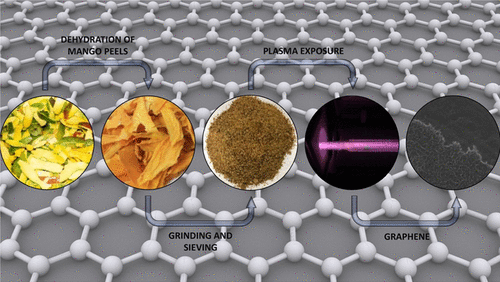Our official English website, www.x-mol.net, welcomes your
feedback! (Note: you will need to create a separate account there.)
Plasma Synthesis of Graphene from Mango Peel
ACS Omega ( IF 3.7 ) Pub Date : 2018-01-16 00:00:00 , DOI: 10.1021/acsomega.7b01825 Javishk Shah 1 , Janneth Lopez-Mercado 2 , M. Guadalupe Carreon 3 , Armando Lopez-Miranda 4 , Maria L. Carreon 1
ACS Omega ( IF 3.7 ) Pub Date : 2018-01-16 00:00:00 , DOI: 10.1021/acsomega.7b01825 Javishk Shah 1 , Janneth Lopez-Mercado 2 , M. Guadalupe Carreon 3 , Armando Lopez-Miranda 4 , Maria L. Carreon 1
Affiliation

|
The excess of mango peels is considered manufacturing waste in the sugar and juice industry. There is an increasing interest in looking for alternative ways to employ this waste to address this overload. Here, we show the efficient use of mango peels as a noncost carbon source for the synthesis of graphene. We demonstrate for the first time the synthesis of graphene on Cu substrates from mango peels, a biomass rich in pectin. It is observed that plasma presence is essential for the growth of graphene from mango peels. At 15 and 30 min of plasma exposure, we observed the presence of multilayered graphene, at longer plasma exposure, i.e., 60 min, there is the formation of monolayer graphene, attributed to the etching of multiple layers formed at short times due to long plasma exposure time. When employing this technique, precautions must be taken due to the etching effect of plasma, such as reducing either the plasma exposure time or the plasma power. Finally, we present a graphene growth pathway under plasma environment on the basis of our experimental observations.
中文翻译:

芒果皮等离子体合成石墨烯
过量的芒果皮被认为是制糖业和果汁业的制造废物。寻找替代方法来利用这种浪费来解决这种过载的兴趣日益浓厚。在这里,我们展示了芒果皮作为石墨烯合成的非成本碳源的有效利用。我们首次证明了芒果皮(一种富含果胶的生物质)在铜基质上合成石墨烯。观察到血浆的存在对于芒果皮中石墨烯的生长至关重要。在等离子暴露的15和30分钟时,我们观察到存在多层石墨烯,在更长的等离子暴露条件下,即60分钟,由于石墨的长等离子体在短时间内形成了多层腐蚀,因此形成了单层石墨烯曝光时间。当采用这种技术时,由于等离子的蚀刻作用,必须采取预防措施,例如减少等离子暴露时间或等离子功率。最后,根据我们的实验观察结果,我们提出了等离子体环境下的石墨烯生长途径。
更新日期:2018-01-16
中文翻译:

芒果皮等离子体合成石墨烯
过量的芒果皮被认为是制糖业和果汁业的制造废物。寻找替代方法来利用这种浪费来解决这种过载的兴趣日益浓厚。在这里,我们展示了芒果皮作为石墨烯合成的非成本碳源的有效利用。我们首次证明了芒果皮(一种富含果胶的生物质)在铜基质上合成石墨烯。观察到血浆的存在对于芒果皮中石墨烯的生长至关重要。在等离子暴露的15和30分钟时,我们观察到存在多层石墨烯,在更长的等离子暴露条件下,即60分钟,由于石墨的长等离子体在短时间内形成了多层腐蚀,因此形成了单层石墨烯曝光时间。当采用这种技术时,由于等离子的蚀刻作用,必须采取预防措施,例如减少等离子暴露时间或等离子功率。最后,根据我们的实验观察结果,我们提出了等离子体环境下的石墨烯生长途径。











































 京公网安备 11010802027423号
京公网安备 11010802027423号